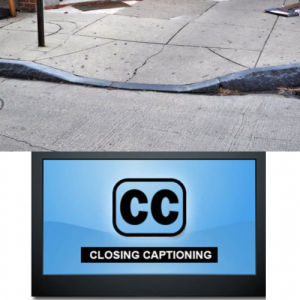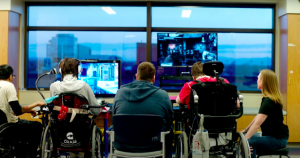Blog
Universal Design: An Environment That Benefits All
What Is Universal Design?
“The concept focuses on “designing all products and the built environment to be aesthetic and usable to the greatest extent possible by everyone, regardless of their age, ability, or status in life.”
Take a look at the following cartoon:

In the cartoon you will see a group of people needing access to a building but there is snow covering both the ramp and the stairs. The group includes people who are standing and one who is in a wheelchair. They are watching the stairs be shoveled by a worker. The worker is shoveling the stairs first and comments to the person in the wheelchair that he will shovel the ramp as soon as he finishes the stairs. The person in a wheelchair notes that if the ramp were to be shoveled before the stairs, everyone would be able to get into the building together. This cartoon illustrates the ways we can view the environment around us and come to the conclusion that if the environment around us was structured with accessibility for all, it would actually benefit all. This concept is known as ‘universal design’. The term was created in the 1970’s by Ronald L. Mace, a member of the American Institute of Architects. Universal design focuses on “designing all products and the built environment to be aesthetic and usable to the greatest extent possible by everyone, regardless of their age, ability, or status in life,” according to the Center For Universal Designs. Ronald said in one of his speeches, “It’s focus is not specifically on people with disabilities, but all people. It actually assumes that everyone has a disability, and I strongly feel that’s the case. We all become disabled as we age and lose ability, whether we want to admit it or not. It is negative in our society to say, ‘I am disabled’ or ‘I am old’. We tend to discount people who are less than what we popularly consider to be ‘normal’. To be ‘normal’ is to be perfect, capable, competent, and independent. Unfortunately, designers in our society also mistakenly assume everyone fits this definition of ‘normal’.
Since then, architects, website designers, and local communities have made progress in creating a more universally designed world. Some examples of how our environment has become more inclusive are curb cuts and closed captioning. Curb cuts are wedges cut into an elevated curb. They were originally created in the 1940’s to make the community more accessible for people in wheelchairs and those who are visually impaired. Since then, they have been useful to those pushing a stroller, carrying heavy bags and objects, pushing a dollie, walking with a cane, joint pain, and even for those using a skateboard. Similarly, closed captions were created to help those who are deaf or hearing impaired. Today, they also help people who have trouble processing information quickly, talk during movies and tv shows, and for watching in a noisy area.

Buttons that automatically open doors to public buildings are critical for those in wheelchairs or visually impaired. However, someone who is carrying items with two hands would find it beneficial to not have to try to open the door. Signs with large lettering, that are easy to read, and placed in a spot where it won’t be blocked aren’t just helpful for those with visual impairments, they are helpful to people who have never been in a particular area and wouldn’t otherwise know where to find information. Storage spaces that are within reach of people who are of various heights allows all to get items from that space without needing assistance. Each day actions are completed that while originally created to help someone with a disability – end up making life easier for all.
Improving Our Own State
In 2015-2016, main street in Concord (NH) went through a complete transformation to help improve the safety, sustainability, and livability throughout the city. According to the City of Concord’s Main Street Design Guide, “the project reduced traffic from four lanes to two, widened sidewalks, and added pedestrian lighting, landscape features, street furniture, and public art. It also provided much-needed space for outdoor dining, gathering, and community-based activities, as well as full access to most storefronts on the street. Overwhelmingly successful, Concord’s transformed Main Street has led to increased activity and vibrancy, and the project has received multiple awards”. Two of those awards, American Public Works Association Public Works Project of the Year and Institute on Transportation Achievement Award, are national recognitions. You can view the Main Street Design Guide HERE to see photos of the many ways main street was transformed. IBI Group, a global architecture firm that collaborated with the city of Concord in their redesign plan said on their website, “the ultimate goal of the project was to transform Concord’s Main Street into a ‘Complete Sheet’ – shifting away from a sole focus on vehicular transportation to simultaneously accommodate pedestrians, drivers, transit users, and bicyclists in equal measure”.

Samuel Habib is an advocate for people with disabilities. In 2017, Samuel, who has cerebral palsy and uses a wheelchair, created a video in downtown Concord where he discussed the accessibility of the area with Mayor Jim Bouley, Developer Steve Duprey, and Cindy Robertson from the Disability Rights Center. You can watch the full video HERE. Not only does Samuel advocate for accessibility in our own state – he is an advocate for accessibility all across the nation. During the 2020 Presidential primary season, he interviewed some of the candidates about topics regarding disability and accessibility.
The Importance of National Government Support
On a national level, legislators have recognized the importance of communities that are accessible to all. On President Joe Biden’s website, joebiden.com/disability, there is a page dedicated to full participation and equality for people with disabilities that you can find HERE. The website states, “People with disabilities, including people with mobility, developmental, and sensory disabilities, must have accessible transportation in order to live, attend school, work, or shop; access health care; and participate in the community. Biden has proposed a comprehensive infrastructure plan which will increase flexible federal investments, help cities and towns install light rail networks, and improve existing transit and bus lines. And, he will create a new program that gives rapidly expanding communities the resources to build in public transit options from the start. Whether improving existing systems or creating new public transit options, those systems will be accessible to all people with disabilities and people with disabilities will be included in the design and implementation of those systems.” The webpage goes on to state that Biden plans on implementing policies to address barriers to accessible transportation, ensure new modes of transportation use universal design and incorporate the needs of people with disabilities, ensure air travel is accessible to people with disabilities, and improve paratransit services.
Universal Design Means Accessibility For All
You may find accessibility, or a lack of accessibility in your own community. Carole Thibodeau, Accounting Coordinator at our area agency said she spent some time in a wheelchair a few years ago after breaking the same bone multiple times. “It was a cold, snowy and icy winter. Getting around outside was a challenge. I found an abundance of “Handicapped Parking” signs everywhere. Wonderful! Until the icy lot in which I exited my car to negotiate around parked vehicles searching for a ramp that didn’t exist. Hmm……..ok, so how to get over a curb? Certainly not without assistance. Then there was the time I attempted to enter a gorgeous modern office building with huge double doors which could have easily accommodated a wheelchair—or a herd of elephants. Yay! But no automatic button to open those massive doors was anywhere to be found,” Carole said. She noted that while her few months in a wheelchair “hardly qualify me as a voice of experience”, the experience was “an eye opener”. “The universal design concept we read about is a great one – for public buildings and private ones alike. With advocacy and input from individuals who have differing needs and abilities, we can make a more accessible world for all – young, old, maneuvering in a wheelchair, pushing a baby stroller, or simply just walking.”
Microsoft Chief Accessibility Officer Jenny Lay-Flurrie said “disability is just a part of being human. It’s frankly a bit nutty to me that we don’t talk about it in general society anywhere near as much as we should, and it is the biggest untapped talent pool out there”. Last month Microsoft launched a five-year initiative to help close the “disability divide” – the gap between the resources and opportunities available to those with and without disabilities. This consists of creating software and hardware technology that is accessible to people with a wide range of abilities, increasing the workforce of people with a disability at the organization, and educating about the importance of hiring people with a disability.

The Healthy Business Streets Guide from the Washington State Department of Health and Environmental Health Services Division for Public Health (Seattle & King County) highlights the importance of businesses continuing to keep universal design in mind when modifying their seating area to follow COVID-19 safety protocols. The guide states, “Designing for people with disabilities must be a core element to any street modification. People who have low or no vision benefit from straight, clear paths and people who rely on mobility devices require ramps to get on and off curbs. Maintaining clear space to navigate the sidewalk and public plazas, ensuring accessibility to curb ramps and bus stops, and locating ADA parking spots are critical considerations. The 2010 ADA Standards for Accessible Design are the foundation for all street design for people with disabilities, which should be embedded into a city’s “right-of-way improvement manual.”
Did you know that universal design doesn’t have to just take place in businesses and other public areas? Your own home can be designed with accessibility in mind. No-step entry, one-story living, wide doorways, wide hallways, extra floor space, and floors/bathtubs with non-slip surfaces are all ways one could make their home more accessible if they wanted to and had the ability to.
In recent years, there has been more and more conversations surrounding inclusion and accessibility for all groups of people. Communities that include ramps to get into businesses, automatic door openers, seating that accommodates one’s needs, and other forms of design that accommodate all – lead to that community becoming a better place!